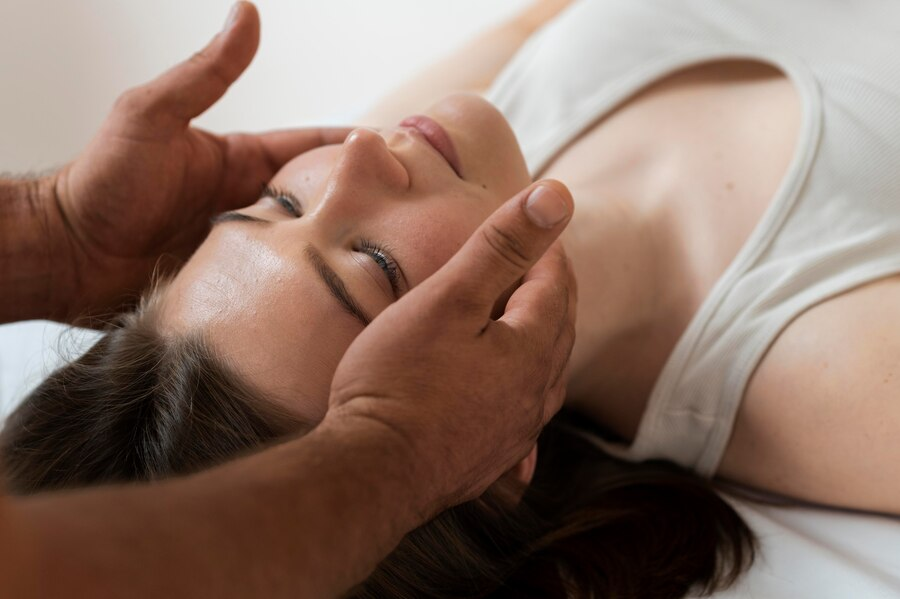Craniosacral Therapy (CST) is a gentle, hands-on approach to healing that has been gaining popularity for its ability to address a variety of health issues. Unlike some more invasive treatments, CST focuses on the subtle movements of the body’s craniosacral system—comprising the skull, spine, and sacrum—and uses light touch to enhance the body’s natural healing processes. This therapy is often praised for its holistic approach and its ability to treat a range of conditions from chronic pain to stress. But what exactly is Craniosacral Therapy, and how does it work? Let’s dive in and explore this fascinating therapeutic technique.
What is Craniosacral Therapy?
Craniosacral Therapy was developed by Dr. John Upledger, an osteopathic physician, in the late 1970s. The therapy emerged from the study of the craniosacral system, which includes the cerebrospinal fluid (CSF) that surrounds and cushions the brain and spinal cord. Upledger discovered that by using gentle touch to manipulate the craniosacral system, practitioners could help release tensions, alleviate pain, and improve overall health.
The central idea behind CST is that the body has an inherent ability to heal itself. By addressing restrictions and imbalances in the craniosacral system, CST aims to support this natural healing process. It’s often described as a gentle and non-invasive therapy, making it accessible to people of all ages and health conditions.
How Does Craniosacral Therapy Work?
Craniosacral Therapy is based on the concept of a rhythmic pulse that can be felt throughout the body, known as the craniosacral rhythm. This rhythm is related to the flow of cerebrospinal fluid, which moves in a cyclic pattern around the brain and spinal cord. Practitioners of CST use light touch to assess this rhythm and detect any abnormalities or restrictions that might be affecting the body’s health.
During a CST session, the patient typically lies down fully clothed while the practitioner gently places their hands on various parts of the body, including the head, neck, spine, and sacrum. The touch is light and subtle, often no more than the weight of a nickel. The practitioner then uses their hands to feel for any restrictions or imbalances in the craniosacral rhythm.
By gently manipulating the craniosacral system, the practitioner aims to release tensions, improve the flow of cerebrospinal fluid, and restore balance to the body. The therapy is designed to help the body’s own healing mechanisms work more effectively, leading to improved overall health and well-being.
Benefits of Craniosacral Therapy
Craniosacral Therapy is known for its wide range of potential benefits. While individual experiences may vary, many people report positive outcomes from CST, including:
Craniosacral Therapy (CST) can significantly alleviate chronic pain conditions like back pain, migraines, and joint pain. By gently addressing restrictions within the craniosacral system, CST helps reduce muscle tension and improve blood circulation, leading to effective pain relief and enhanced comfort.
Stress Reduction
The gentle, soothing nature of CST promotes profound relaxation and significantly reduces stress levels. Many patients report feeling deeply calm and centered after a session, which contributes to overall mental well-being and helps manage daily stress more effectively.
Improved Mobility
For those experiencing stiffness or a limited range of motion, CST can enhance flexibility and mobility. By releasing restrictions within the craniosacral system, this therapy facilitates greater freedom of movement and can help ease discomfort associated with restricted joint or muscle movement.
Many patients experience improved sleep quality following CST sessions. The deep relaxation induced by the therapy can help regulate sleep patterns, leading to more restful and uninterrupted sleep, which is crucial for overall health and well-being.
Support for Emotional Health
CST is sometimes utilized to address emotional issues such as trauma and anxiety. The therapy’s gentle, non-invasive approach helps release stored emotional tension, fostering emotional healing and contributing to a greater sense of overall well-being.
Boosted Immune Function
By enhancing overall health and reducing stress, CST can potentially boost the immune system. A well-balanced craniosacral system supports the body’s natural defenses, making it more resilient to illnesses and infections by promoting a healthier immune response.

Conditions Treated with Craniosacral Therapy
Craniosacral Therapy is used to address a wide variety of conditions. Some of the most common conditions that CST can help with include:
- Headaches and Migraines: CST can help alleviate the frequency and intensity of headaches and migraines by addressing restrictions in the craniosacral system that may contribute to these conditions.
- Chronic Pain: Conditions such as fibromyalgia, lower back pain, and neck pain can benefit from CST by relieving muscle tension and improving overall body function.
- Stress and Anxiety: The relaxation techniques used in CST can help manage stress and anxiety by promoting a sense of calm and well-being.
- Trauma Recovery: CST is sometimes used as part of a trauma recovery process to help release stored emotional and physical tension from past experiences.
- TMJ Disorders: Temporomandibular joint (TMJ) disorders can be alleviated through CST by addressing imbalances in the jaw and surrounding muscles.
- Post-Surgical Recovery: CST can support recovery after surgery by improving circulation, reducing scar tissue formation, and promoting overall healing.
What to Expect During a Craniosacral Therapy Session
If you’re considering Craniosacral Therapy, it’s helpful to know what to expect during a session. Here’s a general overview of what typically happens:
Initial Consultation
Your first visit will likely involve an initial consultation where the practitioner will ask about your health history, current symptoms, and any specific concerns you may have. This helps the practitioner tailor the therapy to your individual needs.
Treatment
During the treatment, you will lie down fully clothed on a comfortable massage table. The practitioner will use their hands to gently palpate and assess the craniosacral rhythm, focusing on areas of tension or restriction.
Gentle Touch
The practitioner will use light touch to work with the craniosacral system. You may feel subtle shifts or sensations as the therapist works to release restrictions and restore balance.
Feedback
Throughout the session, the practitioner may ask for feedback on your experience. It’s important to communicate any sensations or feelings you have so that the therapist can adjust their approach as needed.
Post-Treatment
After the session, you may feel relaxed and refreshed. It’s common to experience a sense of calm and clarity. Some people may also notice changes in their symptoms over the following days as the body adjusts to the therapy.
Craniosacral Therapy and Holistic Health
Craniosacral Therapy is a key component of holistic health practices, embracing a comprehensive approach that integrates mind, body, and spirit. By focusing on the body’s innate healing capacities, CST aligns with holistic principles that emphasize the interconnectedness of physical and emotional well-being. This gentle therapy works by addressing the craniosacral system, helping to restore balance and promote relaxation, which in turn supports the body’s natural self-healing mechanisms.
Incorporating CST into a holistic health regimen can complement other therapeutic modalities, offering a synergistic approach to wellness. This integration enhances overall health by addressing not just physical symptoms but also emotional and mental aspects, fostering a more balanced and harmonious state of being.
Choosing a Craniosacral Therapist
When selecting a Craniosacral Therapist, it’s crucial to choose someone who is both certified and experienced in this specialized field. A qualified therapist should have proper training and credentials, reflecting their ability to effectively practice CST. Don’t hesitate to inquire about their background, training, and therapeutic approach to ensure they meet your specific needs.
A skilled Craniosacral Therapist will prioritize understanding your concerns and conducting a thorough assessment before tailoring the therapy to your individual situation. It’s also important to find a therapist who creates a supportive and comfortable environment, making you feel at ease throughout the treatment process. This rapport is essential for a successful and beneficial therapy experience.
Conclusion
Craniosacral Therapy provides a gentle yet effective approach to healing by addressing a range of conditions through subtle, impactful methods. Focusing on the craniosacral system supports the body’s natural healing processes and enhances overall well-being. For those considering this therapy, selecting a qualified and experienced therapist is crucial. Integrative Chiropractic in Overland Park offers personalized care and a supportive environment for those interested in exploring Craniosacral Therapy. For more information on how this holistic approach can benefit you, contact Integrative Chiropractic at 913-451-7500.

